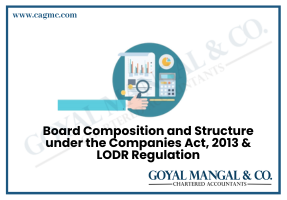
In the ever-changing world of corporate governance, removing a company’s name, which is also called “striking off” or “closing,” is a crucial step that is regulated by the Companies Act. With this mechanism, companies that are no longer in operation can be officially dissolved. This makes sure that the corporate registry only lists current companies. In this comprehensive blog, we will unravel the methods of the Removal of Name or Company Strike off as per the latest provisions of the Companies Act, shedding light on the procedure, reasons, and implications.
Meaning of Removal of Name or Company Strike-of
The removal of a company’s name or closure, also known as company, strike off, under the Companies Act 2013 refers to the formal process of dissolving a company’s legal existence. This mechanism involves either voluntary initiation by the company’s directors and shareholders, or it can be initiated by the Registrar of Companies (RoC) due to non-compliance.
In both cases, the company undergoes a structured procedure to fulfil legal requirements, settle liabilities, and comply with regulatory guidelines before its name is officially struck off from the register, signalling the end of its operations.
Describe the modes with which the company name can be removed
The provisions about the removal of a company’s name are outlined in Section 248 of the Companies Act, 2013. According to this section, there are two methods by which a company’s name can be withdrawn from the Registrar of Companies.
- Voluntary Strike-Off: A firm can dissolve itself through voluntary strike-off, often known as voluntary dissolution or closure. Company directors and shareholders start this procedure. The company normally applies to the Registrar of Companies (RoC) to remove its name from the official register. Inactive companies, that have achieved their goals, or no longer want to operate might voluntarily strike off.
- Strike off by ROC: The Registrar of Companies (RoC) strikes off companies that fail to meet legal and financial responsibilities. If a firm fails to file its financial statements, annual returns, or other essential documents for an extended period, the RoC may strike its name from the official register. Involuntary strike-offs ensure the correctness and integrity of the corporate registration
Voluntary strike-off company procedur
Following is the process of the voluntary closure of a company under the Companies Act
- Board Meeting: Board meeting to be held for approval of strike off company, Extinguishment of obligation of Companies, Director authorization for petition to ROC for strike off; and Approval of date, day, place, and notice thereof for concluding General Meeting.
- EGM Notice: All shareholders must receive a notice of the EGM together with a copy of the Board Meeting notification. The EGM notice must be sent 21 days in advance.
- Hold EGM: The EGM will be held to get the shareholder approval for the company name removal by passing a special resolution or by getting 75% of the paid-up Company share capital member’s assent.
- Filing Application to ROC: The Company must file to ROC Form STK-2 to remove its name. Company Directors must sign the application.
- Director Declaration: The declaration of the director must be there in Form STK -2, containing various information that needs to be declared for removal of the name of the company or voluntary strike off.
- Certification: A whole-time practitioner CA, CS or Cost Accountant must verify form STK-2
- Notice & Objection Publication: The Registrar of Companies will ask for objections to the proposed name change by publishing a notice. The objection must reach the Registrar within 30 days of notice posting. The Registrar may also obtain liability discharge agreements from management, directors, or other responsible parties.
- Company Dissolution: If no valid objections are submitted, the Registrar will remove the company’s name from the ROC after considering all relevant factors. Form STK-7 will notify the Official Gazette of the withdrawal. Therefore, the company will dissolve from the date specified in the notice.

Attachment with Form STK – 2
Documents needed with Form STK-2 are:
- Copy of Extraordinary General Meeting Special Resolution; or consent of 75% of Company members based on paid-up share capital.
- Explanatory Statement of Notice
- Form STK-3 Indemnity Bond, certified by two Directors on Rs. 500 stamp paper, notarized by advocate and attorney.
- STK-8 Statement of Account, certified by Chartered Accountants, presenting NIL Asset and NIL Liability within 30 days of member approval for strike-off.
- Board Resolution for company closure
- Closure letter of bank account
- Main Object of company
- NOC (No Objection Certificate) from the company’s registration regulators
- At least two directors’ STK-4 affidavits on Rs. 100 stamp paper fully notarized by advocate and attorney, along with self and CA / CS / CMA certified pan and Aadhar cards for identity and address evidence.
The Registrar of Companies must carefully verify that the company has made adequate provisions to pay all outstanding debts and fulfil its liabilities and obligations within a reasonable timeframe after receiving the application. If necessary, the ROC may request undertakings from the managing director, director, or other firm managers.
After completing the above requirements, the ROC will announce the company’s closure. After the notice’s deadline, the Registrar can strike the company’s name from the register. The strike-off will be announced in the Official Gazette. After this notification is published in the Official Gazette, the corporation will dissolve.
Director Declaration in detail
The following things the director declared in Form STK-2:
- No inspection or investigation has been ordered or conducted against the company, and no prosecution is ongoing in any court deriving from such inspection or inquiry.
- The company does not possess any outstanding public deposits, nor is it in default regarding the repayment or interest associated with such deposits.
- The company does not have any existing loans, whether secured or unsecured.
- The company does not possess any outstanding obligations about income tax, VAT, excise duty, service tax, or any other form of tax or duty, regardless of nomenclature, which is payable to the Central or any State Government, statutory authority, or local authority.
- Additionally, all remaining liabilities of the company have been resolved, settled, or eliminated.
- The company has fulfilled all obligations outlined in the Companies Act and its associated regulations concerning the removal of the company’s name from the register of companies, as well as any related or supplementary matters.
Describe Individuals who are deemed ineligible to apply under Section 248.
According to Section 249 of the Act, individuals are deemed ineligible to apply to Section 248:
- If the company undergoes a name change or relocates its registered office from one State to another within three months before the submission of Form STK-2.
- If the company has divested any property or rights within the same three-month period before submitting Form STK-2. This rule does not apply to trade activities when the disposal of property for profit is a regular part of conducting business.
- Additionally, if the company has engaged in any activity that is not specified in the Memorandum of Association or deemed necessary within three months before filing Form STK-2, it is subject to this section.
- If the company has applied to the Tribunal seeking approval for a compromise or arrangement, and the case has not yet reached a final resolution
- If the firm is undergoing liquidation proceedings.
Procedure for Strike off by ROC
The Registrar of Companies (ROC) has the authority to initiate the process of striking off a company from the register if there is reasonable cause to believe that any of the below conditions fulfilled:
- The company has failed to commence its business within one year of its incorporation.
- The company has not engaged in any business or operations for a consecutive period of two financial years and has not applied to be classified as a dormant company during this period,
- The subscribers to the memorandum have not fulfilled their obligation to pay the subscription amount as agreed upon during the company’s incorporation, and the requisite form INC 20A has not been filed within 180 days.
- The company is currently not engaged in any business or operational activities, as discovered during the physical verification conducted by the Registrar of Companies at the registered office of the company.
- The Registrar of Companies (RoC) will transmit the notification in electronic form STK-1 to the company to strike it off the register and will notify them to submit a representation along with the necessary documentation within 30 days.
- If the company fails to provide a defence within 30 days, the Registrar of Companies (RoC) will issue a public notice to allow for objections from the public.
- This notification will be in the form of E-form STK-5. Moreover, in the absence of any objections, the Registrar of Companies (RoC) shall proceed to issue a notification in the Official Gazette in the form of E-STK-7, about the strike-off and dissolution of the company.
Takeaway
The process of removal of names or closure of companies under the Companies Act embodies the principle of maintaining an accurate and updated corporate registry. While it provides a way to dissolve inactive entities, due diligence is crucial to navigate the procedure and understand its consequences fully. As the corporate landscape continues to evolve, complying with the Companies Act’s provisions contributes to a transparent and well-regulated business environment







